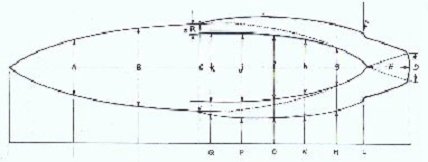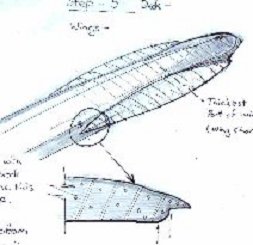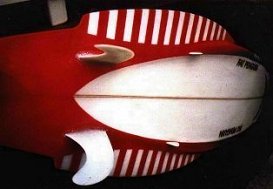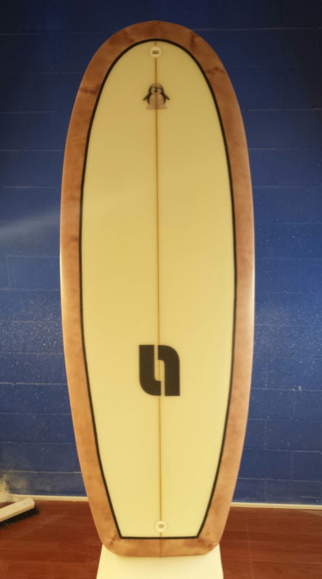I give you…
Archimedes, Newton…bernoullis principal, fitster valves, ball bearings, 40 wt oil, NASA…the fricking Space Shutle…Ventral fins, spitster boatail bullet…F16’s and migs. This bad baby has it all. If you don’t understand it, you can’t make it, so please leave this design for the pros. If you miss one of the critical design attributes…ie, the Bernoulli Principle, or proper placement of the fitster valve…just to name a few, you might be liable for a wrongful death suit…so please , please don’t do this at home. this board must be made in an Ebola entrusted…encrusted authorized work environment. But 99.9% of you will not be able to understand or even comprehend, or even know what this is amazing breakthrough is about. But trust me, it’s all about the math…all you got to do is understand the math. Just follow the math and logic and you will be surfing like a pro in a matter of days.
read on at your own risk.
**The Physics of the Fat Penguin **
The hard science used to evolve the FP project is the same as NASA and Japanese Aerospace Engineers used in designing the space shuttle and NASP pressure wave gliders. There is also a mathematical formula to describe the flow shape that took over two years to assemble using the theories of Archimedes, Newton, Freude, Reynolds, Chung, Burt, Rutan, and Helmholtz. This was a big headache to get through yet it was vitally important that the core theory of making the project sound.
When Simon Anderson introduced the thruster fin system in 1976, it revolutionized the way surf craft would plane. The Fat Penguin is an Aquatic Glider with far higher lift/drag ratios then planning gliders, making it more efficient. An analogy would be a paper kite compared to a glider.
**What is an Integrated Flow Form? **
Answer- The Fat Penguin is comprised of subsections.
(1) NOSE
(2) TAIL
(3) BOTTOM
(4) DECK
(5) WINGS
(6) RAIL LINE
(7) FINS
(1) NOSE
(2) TAIL
(3) BOTTOM
(4) DECK
(5) WINGS
(6) RAIL LINE
(7) FINS
 The nose is like a big wave speed board built to drive, great for late take-offs. It has a low area high speed profile that smoothes out chop and has the ability to really attack a wave
The nose is like a big wave speed board built to drive, great for late take-offs. It has a low area high speed profile that smoothes out chop and has the ability to really attack a wave
**TAIL **
Slightly rounded 5"to 6" Square tail chosen for stability and to give a straighter and faster rear rail line with small enough surface area enabling high speed cutbacks. The tail works well high in a wave and suits vertical maneuvers.
**BOTTOM **
 The concave provides lift. You cannot compress a liquid so it accelerates. By the time it reaches the tip of the concave the fluid is moving faster than the fluid at the edge of the board. The concave tip shape is very important; it directs the accelerated fluid flow to the sudden tail lift. The sudden tail lift at the end of the concave running into the back of the board encourages the rear stern pressure waves to return early under the tail of the board, creating a high pressure zone under the tail. This recycles energy rather than throwing it away as spray. Water flows from a larger area to a smaller surface area and into the tail quickly - great for snap turns. The vee bottom was added for stability, cutbacks and tight hard turns. Work on stern pressure waves was based on Professor Dubeur.
The concave provides lift. You cannot compress a liquid so it accelerates. By the time it reaches the tip of the concave the fluid is moving faster than the fluid at the edge of the board. The concave tip shape is very important; it directs the accelerated fluid flow to the sudden tail lift. The sudden tail lift at the end of the concave running into the back of the board encourages the rear stern pressure waves to return early under the tail of the board, creating a high pressure zone under the tail. This recycles energy rather than throwing it away as spray. Water flows from a larger area to a smaller surface area and into the tail quickly - great for snap turns. The vee bottom was added for stability, cutbacks and tight hard turns. Work on stern pressure waves was based on Professor Dubeur.
**DECK **
The deck draws on “Bernoulli’s principles” to create a narrow waist to encourage the fluid flow to hug the body form e.g. Spitster boatail bullet, SR.71 Blackbird, Migs, f16.
**WINGS **
 The wings are called pectoral flyers. They add stability and lift when trimming or driving and their effect is very noticeable in white water.
The wings are called pectoral flyers. They add stability and lift when trimming or driving and their effect is very noticeable in white water.
-
to provide surface area and lift at low speed.
-
to create a rear section Rail line of a modern short board 19.5" wide
-
for change of rocker. In full rail bottom turns you use the full rocker for big arcs. The wings at speed are neutral stabilizers you wouldn’t know they were there. For short radius turns the change in rocker makes this easy. Check out a photo of surfers doing cutbacks or tight top slashes. They are only using the back half of their boards. The wing chord profiles a copy of a mach 2.5 low form.
-
to provide surface area and lift at low speed.
-
to create a rear section Rail line of a modern short board 19.5" wide
-
for change of rocker. In full rail bottom turns you use the full rocker for big arcs. The wings at speed are neutral stabilizers you wouldn’t know they were there. For short radius turns the change in rocker makes this easy. Check out a photo of surfers doing cutbacks or tight top slashes. They are only using the back half of their boards. The wing chord profiles a copy of a mach 2.5 low form.

**RAIL LINE **
The rail line is hard and low at the nose and progressively softens to the board’s widest point; the back one third of the rail is hard and low.
**FINS **
 There are two sets of fins on the FP. The front set are called VENTRAL FINS and are there to stop yawing at high speed and in a tight turn they act like a Carnard wing helping steer the board round them. The rear fins are a set of twin fins about the size of a single fin with the base area cut away to make them loose at low speeds. The third thruster fin was made redundant by the pintail concave and tail relief.
There are two sets of fins on the FP. The front set are called VENTRAL FINS and are there to stop yawing at high speed and in a tight turn they act like a Carnard wing helping steer the board round them. The rear fins are a set of twin fins about the size of a single fin with the base area cut away to make them loose at low speeds. The third thruster fin was made redundant by the pintail concave and tail relief.





















 The nose is like a big wave speed board built to drive, great for late take-offs. It has a low area high speed profile that smoothes out chop and has the ability to really attack a wave
The nose is like a big wave speed board built to drive, great for late take-offs. It has a low area high speed profile that smoothes out chop and has the ability to really attack a wave The concave provides lift. You cannot compress a liquid so it accelerates. By the time it reaches the tip of the concave the fluid is moving faster than the fluid at the edge of the board. The concave tip shape is very important; it directs the accelerated fluid flow to the sudden tail lift. The sudden tail lift at the end of the concave running into the back of the board encourages the rear stern pressure waves to return early under the tail of the board, creating a high pressure zone under the tail. This recycles energy rather than throwing it away as spray. Water flows from a larger area to a smaller surface area and into the tail quickly - great for snap turns. The vee bottom was added for stability, cutbacks and tight hard turns. Work on stern pressure waves was based on Professor Dubeur.
The concave provides lift. You cannot compress a liquid so it accelerates. By the time it reaches the tip of the concave the fluid is moving faster than the fluid at the edge of the board. The concave tip shape is very important; it directs the accelerated fluid flow to the sudden tail lift. The sudden tail lift at the end of the concave running into the back of the board encourages the rear stern pressure waves to return early under the tail of the board, creating a high pressure zone under the tail. This recycles energy rather than throwing it away as spray. Water flows from a larger area to a smaller surface area and into the tail quickly - great for snap turns. The vee bottom was added for stability, cutbacks and tight hard turns. Work on stern pressure waves was based on Professor Dubeur. The wings are called pectoral flyers. They add stability and lift when trimming or driving and their effect is very noticeable in white water.
The wings are called pectoral flyers. They add stability and lift when trimming or driving and their effect is very noticeable in white water.
 There are two sets of fins on the FP. The front set are called VENTRAL FINS and are there to stop yawing at high speed and in a tight turn they act like a Carnard wing helping steer the board round them. The rear fins are a set of twin fins about the size of a single fin with the base area cut away to make them loose at low speeds. The third thruster fin was made redundant by the pintail concave and tail relief.
There are two sets of fins on the FP. The front set are called VENTRAL FINS and are there to stop yawing at high speed and in a tight turn they act like a Carnard wing helping steer the board round them. The rear fins are a set of twin fins about the size of a single fin with the base area cut away to make them loose at low speeds. The third thruster fin was made redundant by the pintail concave and tail relief.